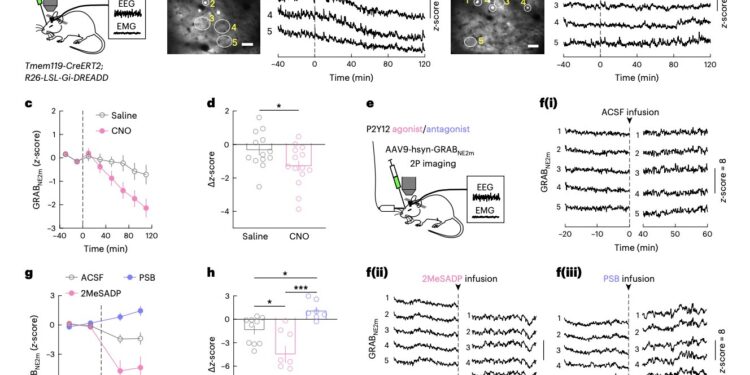Activation of microglial Gi signaling suppresses NE transmission. a, Schematic of GRABNE2m imaging in the prefrontal cortex. b, Example of an imaging session with chemogenetic activation of Gi in microglia. Left, field of view (scale bar, 50 µm); five ROIs are described, the NE traces of which are shown on the right. Dotted line, time of CNO or saline injection. c, effect of chemogenetic activation of Gi in microglia on NE signals averaged over 13 (saline) or 14 (CNO) sessions from five mice: three females and two males. In total, 8 to 12 ROIs were assessed for each session. The dotted line indicates the time of injection. d, Difference in NE before and after (20 to 120 min) an injection of saline or CNO. Each circle represents data from one session (saline, n = 13 sessions; CNO, n = 14 sessions; from five mice). Data are presented as mean ± sem; *P. Credit: Ma et al.
We know that sleep plays a key role in facilitating various physiological processes, while contributing to the proper functioning of the brain. Lack of sleep and poor sleep quality have been linked to a variety of chronic health and mental health problems, including high blood pressure, depression, stroke, obesity, and heart disease.
Sleep disorders have also been implicated in the development of neurodegenerative diseases. Interestingly, neurodegenerative diseases have also been linked to dysfunction of microglia, the main immune cells of mammals, but the link between microglia and sleep has not yet been studied extensively.
Researchers from the University of California, Berkeley (UC Berkeley), Huazhong University of Science and Technology, and other institutes in China recently conducted a study exploring the potential role of microglia in regulating sleep. Their findings, published in Natural neurosciencesuggest that microglia regulate sleep by modulating the transmission of the neurotransmitter norepinephrine, known to contribute to arousal, attention, and stress responses.
“We show in mice that microglia can regulate sleep through a mechanism involving GI -GPCR coupled, intracellular Ca2+ signaling and suppression of norepinephrine transmission,” Chenyan Ma, Bing Li and colleagues wrote in their paper.
To study the role of microglia in regulating sleep, the researchers conducted a series of experiments on mice, using chemogenetic techniques to manipulate and image microglia signaling in their brains. Specifically, they selectively activated or blocked P2Y12, a Gi protein-coupled ATP/ADP receptor that has been shown to be essential for microglia function.
The team observed the neural mechanisms that followed the experimental activation/blocking of P2Y12-Gi signaling and recorded the sleeping behavior of the mice. This allowed them to gather new information about how microglia can regulate sleep in mice, and potentially also in humans and other mammals.
“Chemogenic activation of microglia GI signaling strongly promotes sleep, whereas pharmacological blockade of Gi-coupled P2Y12 receptors decreases sleep,” the researchers wrote.
“Two-photon imaging in the cortex showed that P2Y12-GI elevated intracellular Ca activation of microglia2+and blocking this Ca2+ elevation largely suppressed the Gi-induced increase in sleep. Microglia Ca2+ The level also increased during natural transitions between waking and sleeping, partly due to reduced norepinephrine levels. Furthermore, imaging of norepinephrine with its biosensor in the cortex showed that P2Y12-G microgliaI activation significantly reduced norepinephrine levels, in part by increasing adenosine concentration.
Overall, the results collected by Ma, Li and their colleagues suggest that microglia play a key role in sleep regulation. Specifically, these immune cells appear to regulate sleep via reciprocal interactions with norepinephrine transmission.
These initial observations could soon pave the way for further studies investigating the role of microglia in sleep regulation, focusing on norepinephrine transmission.
As microglial dysfunction and sleep disturbances have been associated with Alzheimer’s disease and other neurodegenerative diseases, this work could also expand neuroscientists’ understanding of these diseases, potentially contributing to the future development of new therapeutic strategies. .
More information:
Chenyan Ma et al, Microglia regulate sleep through calcium-dependent modulation of norepinephrine transmission, Natural neuroscience (2024). DOI: 10.1038/s41593-023-01548-5.
© 2024 Science X Network
Quote: Study reveals that microglia could regulate sleep via modulation of norepinephrine transmission (February 7, 2024) retrieved February 8, 2024 from
This document is subject to copyright. Apart from fair use for private study or research purposes, no part may be reproduced without written permission. The content is provided for information only.



